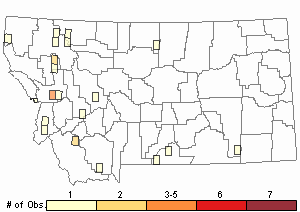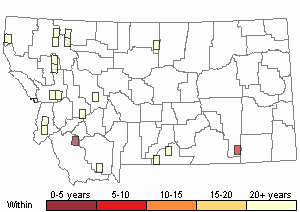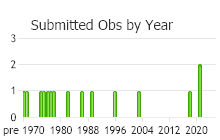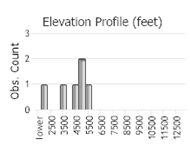View in other NatureServe Network Field Guides
NatureServe
Montana
Utah
Wyoming
Idaho
Wisconsin
British Columbia
South Carolina
Yukon
California
New York
Shiny Nodding Moss - Pohlia cruda
General Description
Plants: Acrocarpous (FNA 2014), growing in soft, open, clumps of upright shoots, pale green (Crum and Anderson et al.1981), whitish-green, sometimes tinged with blue, glossy. Stems 2-25 mm tall (FNA 2014) or sometimes to 40 mm, russet, seldom forked, with a small number of rhizoids (Lawton 1971).
Leaves: Loosely upright to spreading about 45 degrees or more when damp (FNA 2014), similar when dry, smaller and more distant below, becoming longer, more slender and crowded above (Crum and Anderson et al.1981), egg-shaped to lance-shaped with ovate tendencies (Lawton 1971) or lance-shaped, sometimes widest near the middle, narrowing to the acute leaf tip; leaf edges flat (FNA 2014) or slightly curved back and downward in the upper stem leaves (Lawton 1971), in the apical region saw-toothed or finely so; costa ending near the leaf tip (FNA 2014) to well below it (Crum and Anderson et al.1981), red near the attachment (Lawton 1971).
Leaf Cells: Upper medial laminal cells long, narrow, and diamond-shaped to wavy and worm-like, with fine walls (FNA 2014).
Phenology
Fruit ripens in summer (FNA 2014).
Range Comments
North American Range
Canada: YT to NU, BC to NL and NS; USA: AK, west of (to the coastal states) and including MT s to NM, SD and NE, MN and IA, MI, PA ne to ME and s to NC, also TN; Mexico (FNA 2014). Known in Montana from Carbon, Carter, Cascade, Deer Lodge, Flathead, Gallatin, Glacier, Lake, Lewis and Clark, Lincoln, Missoula, and Ravalli Counties (Elliott and Pipp 2016).
Observations in Montana Natural Heritage Program Database
Number of Observations: 27
(Click on the following maps and charts to see full sized version)
Map Help and Descriptions
Relative Density

Recency



 (Observations spanning multiple months or years are excluded from time charts)
(Observations spanning multiple months or years are excluded from time charts)
Habitat
Soil and humus, embankments along trails and beneath protective sods and hanging roots, fissures in bluffs and large stones (Crum and Anderson et al.1981); montane (FNA 2014), occurring from lowlands (Lawton 1971) to high elevations (FNA 2014).
Reproductive Characteristics
Antheridia in axils of perichaetia or upper leaves (FNA 2014), occasionally mixing with the archegonia (Crum and Anderson et al.1981), seldom dioicous. Perigonia long and thin to narrowly lance-shaped in dioicous plants, the base egg-shaped. Perichaetial bracts long, slender and lance-shaped, quite to faintly distinct from the stem leaves (FNA 2014). Seta 10-30 mm tall (Lawton 1971), solitary, brown, and sometimes tinged with orange. Capsule carried well-beyond the perichaetial bracts, straw-colored to brown with orange tones, inclined slightly away from vertical to drooping about 135 degrees, long and narrow (FNA 2014); urn (including neck) 3-4.5 mm in length; neck typically not as long as the remainder of the capsule and not clearly demarcated (Lawton 1971); stomata occurring on the capsule’s surface (FNA 2014) in the neck region (Crum and Anderson et al.1981); exostome teeth slender and deltoid, ochre to russet, pitted below (FNA 2014), finely and thickly papillose above (Crum and Anderson et al.1981); endostome processes keeled, with openings on the keel; cilia ranging from short to tall (FNA 2014), knobby (Lawton 1971).
Stewardship Responsibility
References
- Literature Cited AboveLegend:
 View Online Publication
View Online Publication Crum, H.A. and L.E. Anderson. 1981. Mosses of Eastern North America. 2 volumes. Columbia University Press, New York. 1328 pp.
Crum, H.A. and L.E. Anderson. 1981. Mosses of Eastern North America. 2 volumes. Columbia University Press, New York. 1328 pp. Elliott, J.C. and A.K. Pipp. 2018. A Checklist of Montana Mosses (1880-2018). Updated 3 January, 2020. Montana Natural Heritage Program, Helena, Montana. 73 pp.
Elliott, J.C. and A.K. Pipp. 2018. A Checklist of Montana Mosses (1880-2018). Updated 3 January, 2020. Montana Natural Heritage Program, Helena, Montana. 73 pp. Flora of North America Editorial Committee, eds. 2014. Flora of North America North of Mexico. Volume 28. Bryophytes: Mosses, Part 2. Oxford University Press, Inc., NY. xxi + 702 pp.
Flora of North America Editorial Committee, eds. 2014. Flora of North America North of Mexico. Volume 28. Bryophytes: Mosses, Part 2. Oxford University Press, Inc., NY. xxi + 702 pp. Lawton, E. 1971. Moss Flora of the Pacific Northwest. Hattori Botanical Laboratory. Japan: Yamabuki-cho, Shinjuku-ku, Tokyo. 362 pages plus appendices.
Lawton, E. 1971. Moss Flora of the Pacific Northwest. Hattori Botanical Laboratory. Japan: Yamabuki-cho, Shinjuku-ku, Tokyo. 362 pages plus appendices.
- Additional ReferencesLegend:
 View Online Publication
View Online Publication
Do you know of a citation we're missing? Aho, Ken Andrew. 2006. Alpine and Cliff Ecosystems in the North-Central Rocky Mountains. Ph.D. Dissertation. Bozeman, Montana: Montana State University. 343 p.
Aho, Ken Andrew. 2006. Alpine and Cliff Ecosystems in the North-Central Rocky Mountains. Ph.D. Dissertation. Bozeman, Montana: Montana State University. 343 p. Elliot, J. C. 1993. Second checklist of Montana mosses. Unpublished report. U.S. Forest Service, Region 1. Missoula, MT. 45 pp.
Elliot, J. C. 1993. Second checklist of Montana mosses. Unpublished report. U.S. Forest Service, Region 1. Missoula, MT. 45 pp. Flowers, S. 1973. Mosses: Utah and the West. Brigham Young University, Provo, Utah. 567 p.
Flowers, S. 1973. Mosses: Utah and the West. Brigham Young University, Provo, Utah. 567 p. Lawton, E. 1971. Keys for the Identification of the Mosses on the Pacific Northwest. Reprinted from 'Moss Flora of the Pacific Northwest'. Published as Supplement No. 2 of the Journal of the Hattori Botanical Laboratory. Nichinan, Miyazaki, Japan. 66 pp.
Lawton, E. 1971. Keys for the Identification of the Mosses on the Pacific Northwest. Reprinted from 'Moss Flora of the Pacific Northwest'. Published as Supplement No. 2 of the Journal of the Hattori Botanical Laboratory. Nichinan, Miyazaki, Japan. 66 pp. Malcolm, B., N. Malcolm, J. Shevock, and D. Norris. 2009. California Mosses. Nelson, New Zealand: Micro-Optics Press. 430 pp.
Malcolm, B., N. Malcolm, J. Shevock, and D. Norris. 2009. California Mosses. Nelson, New Zealand: Micro-Optics Press. 430 pp. Smith, A.J.E. 1980. The Moss Flora of Britain and Ireland. Cambridge University Press, Cambridge. 705 pp.
Smith, A.J.E. 1980. The Moss Flora of Britain and Ireland. Cambridge University Press, Cambridge. 705 pp. Vitt, D. J. Marsh, and R. Bovey. 1988. Mosses, Lichens & Ferns of Northwest North America. Seattle, WA: University of Washington Press. 296 p.
Vitt, D. J. Marsh, and R. Bovey. 1988. Mosses, Lichens & Ferns of Northwest North America. Seattle, WA: University of Washington Press. 296 p.
- Web Search Engines for Articles on "Shiny Nodding Moss"





